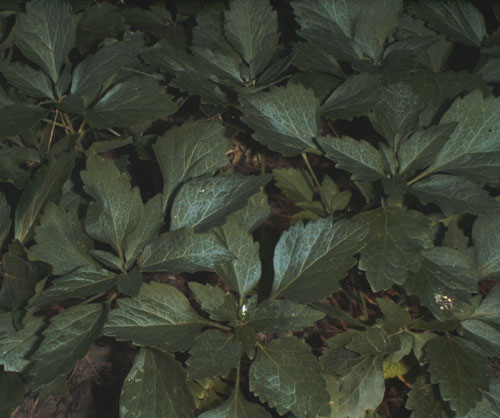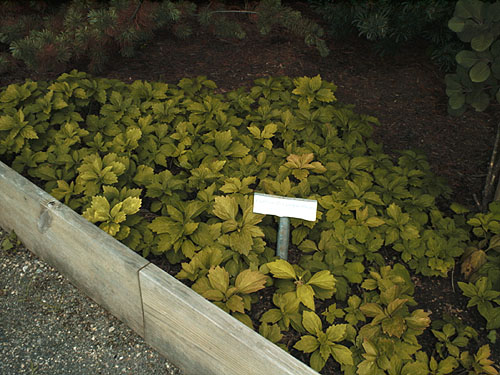Pachysandra procumbens
Allegheny Pachysandra, Allegheny Spurge
Buxaceae
ExpandHabitat
- native to West Virginia down through Louisiana and across to Florida
- hardy to zone 5, and warmer parts of 4
Habit and Form
- a semi-evergreen groundcover
- spreads by rhizomes
- forms a dense and solid carpet of vegetation
- grows 6" to 10" high
- medium texture
- slow growth rate
Summer Foliage
- simple evergreen leaves
- leaves are held clustered at the tips of shoots in whorls, with several inches of naked basal stem present
- leaf arrangement is alternate
- leaves are 2" to 4" long and 2" to 3" wide
- somewhat pubescent
- ovate leaf shape
- toothed leaf margins
- mosaic pattern can sometimes be found on leaf surface
- blue-green leaf color
Autumn Foliage
- semi-evergreen, no fall color
Flowers
- pinkish white flowers
- fragrant
- borne in spikes, 2" to 4" long
- blooms in April
- showy
Fruit
- dehiscent capsule
- blackish brown seeds
- rarely seen on plant
Bark
- brown stems with a purplish tinge
- glabrous
Culture
- prefers moist, acidic, organic, well-drained soil
- partial to full shade
- requires weed control during establishment
- once established, relatively easily grown
- avoid poorly drained, heavy clay soils
Landscape Use
- one of the best groundcover for shade
- good for erosion control, sloped shady banks
- works well under shade trees where lawn growth is poor
- naturalizing
Liabilities
- no serious pest problems
- is not affected by scale, leaf spot or dieback common to P. terminalis
- leaf removal can be challenging
ID Features
- low semi-evergreen groundcover
- rhizomatous growth
- foliage in terminal whorls
- mosaic pattern on leaf surface
- blue-green leaf color
- fragrant flower spikes
Propagation
- by cuttings, easy
Cultivars/Varieties
'Eco Treasure' - This selection from Georgia features more highly variegated (marked) leaves.
'Forest Green' - Often grown and marketed as a superior selection, this cultivar appears to be identical to the species.
'Pixie' - A new novelty form discovered at an Ohio arboretum, this miniature selection only reaches 4" tall and slowly forms clumps. It is otherwise identical to the species. This plant is offered by some specialty catalogs.


